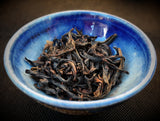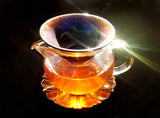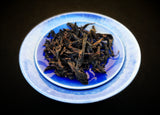This semi-arboreal cultivar was created by the Fujian Agricultural Science Institute in 1998, by crossing Huang Dan (Yellow Elixir) with Tie Guan Yin (Iron Guan Yin). It is characterized by its penetrating and refreshing fragrance, and possesses the "all-day fragrance," characteristic of a Huang Dan.
This tea carries a jasmine aroma, with darker, spicier, richer elements of plum and yellow persimmon. Its flavor has a caramel-banana sweetness, with a slight tartness on the back of the tongue, and is reminiscent of amber. This tea is vibrant, and astringent yet smooth. It leaves a ringing yun sweetness on the tongue, and makes the mouth water.
This particular Yellow Guanyin was naturally grown alongside the banks of the Nine Bends River, in the Wuyi Mountains.
Lasts ~10 brews.
Nomenclature: The Chinese name of this tea is 黄觀音/黄观音
黄 - Huáng - Yellow. In Daoist thought, this represents the center and the phase-element of Earth.
觀/观 - Guān - Observe. 觀 is the traditional form of the character, while 观 is its simplified form. The right side of this character (見/见) means "watch" or "see" and is derived from the character for an eye (目). The left side of this character (雚) is the character for a stork or a heron, composed of the character for bird (隹) with a couple marks to represent feathers on top (艹), and two mouths (口), to represent the calling of the birds. Thus, this means to observe, as a bird would while flying overhead.
音 - Yīn - Sound, tone, pitch. The traditional Chinese musical scale consists of five major notes (Yīn) and six minor notes (Lǜ). These five major notes are the five Yīn, which relate to the Five Phases, which can be used as a paradigm by which all cyclic transformations can be understood. The Ling Shu Jing, or Spiritual Pivot (part of the Bible of Chinese medicine) states that: "Internally, there are the five yin organs, which correspond with the five Yīn (major tones), the five colors, the five times, the five flavors, and the five positions. Externally, there are the six yang organs, which correspond to the six Lǜ (minor notes)... such that the yin and yang organs mirror the way of Heaven." These five Yīn form the notes of the pentatonic scale, give the fundamental tuning of the body, and form the basis of sound healing.
觀音/观音 - Guān Yīn - This is the Chinese Bodhisattva of compassion. Guān Yīn was originally the Bodhisattva Avalokitesvara, meaning The One Who Hears the Ten-Thousand Cries of the World. Thus, the sounds that Guan Yin is aware of/observing are the cries of the suffering, to whose aid Guan Yin/Avalokitesvara will come.
The name of this tea comes from the fact that it is a cross between Huang Dan (Yellow Elixir) and Tie Guan Yin (Iron Guan Yin). The names are combined to form Huang Guan Yin (Yellow Guan Yin). As Yellow relates to Earth and the center, this name evokes the notion of Guan Yin occupying the center, the intersection of the Five Phases, from where she governs all transformations and compassionately attends to all the myriad beings that call the Earth their home. The sounds she perceives are both the requests for aid from all sentient beings and are the sounds of the Five Phases/Elements, which form the vibrational basis for the energetic transformations that make up the entire universe.







